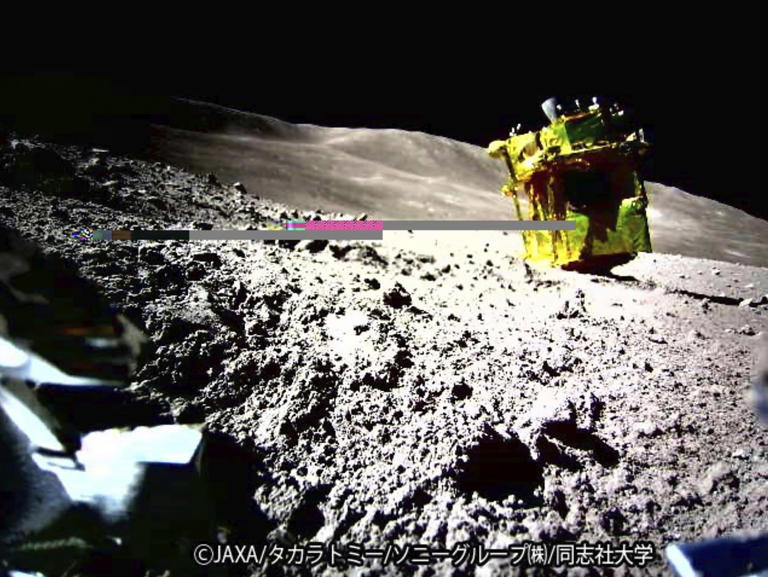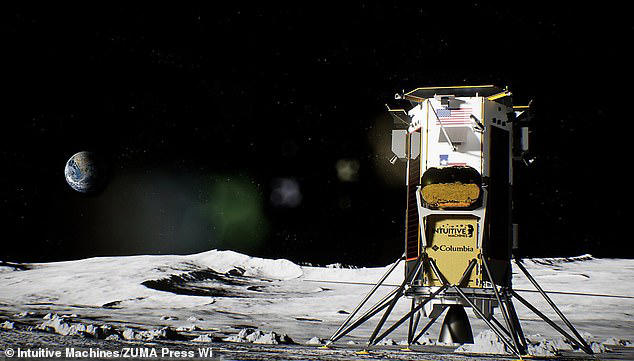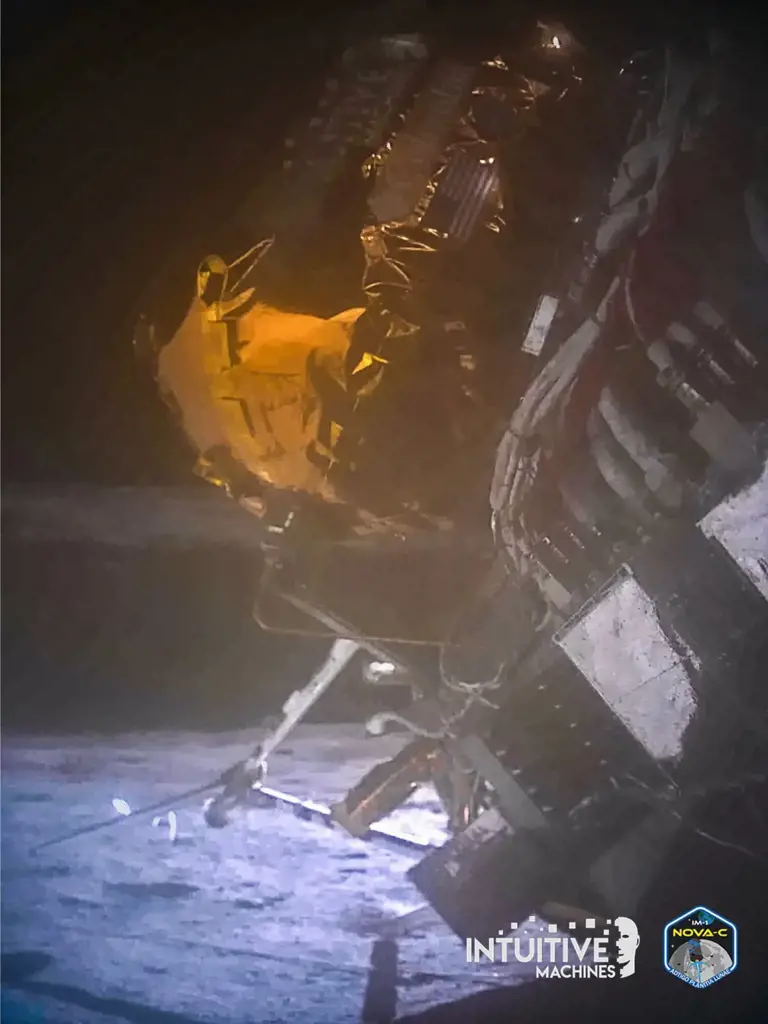New Mars Forums
You are not logged in.
- Topics: Active | Unanswered
Announcement
Pages: 1
#1 2024-02-22 18:17:44
- tahanson43206
- Moderator
- Registered: 2018-04-27
- Posts: 17,200
Odysseus Lander on the Moon
The Odysseus moon landing has been a success! Despite technical issues nearly causing a delay, Odysseus reached the surface of the moon at approximately 6:23 p.m. ET. "We can confirm without a doubt the equipment is on the moon," Dr. Tim Crane said on the NASA broadcast.
38 minutes ago
Odysseus moon landing updates: Nova-C makes first ... - ABC News
abcnews.go.com › Technology › story
About Featured Snippets
(th)
Online
#2 2024-02-22 18:18:16
- tahanson43206
- Moderator
- Registered: 2018-04-27
- Posts: 17,200
Re: Odysseus Lander on the Moon
This post is reserved for an index to posts NewMars members may contribute.
(th)
Online
#3 2024-02-23 09:58:43
- GW Johnson
- Member
- From: McGregor, Texas USA
- Registered: 2011-12-04
- Posts: 5,459
- Website
Re: Odysseus Lander on the Moon
The news story I saw yesterday on the NBC news website said the vehicle had a laser rangefinder to look for obstacles to avoid, during the terminal phase of the landing. According to the story, that vehicle laser rangefinder failed, and they re-purposed an unidentified "something" in one of the on-board experiments, to serve that obstacle-avoidance function. Perhaps that was the roughly 3-hour delay actually doing the landing, and perhaps not. Whatever, it seems to have worked well enough.
GW
GW Johnson
McGregor, Texas
"There is nothing as expensive as a dead crew, especially one dead from a bad management decision"
Offline
#4 2024-02-24 14:50:47
- GW Johnson
- Member
- From: McGregor, Texas USA
- Registered: 2011-12-04
- Posts: 5,459
- Website
Re: Odysseus Lander on the Moon
News stories since say the Intuitive Machines lander ended up on its side. Nobody seems to know how or why that happened, at least not yet.
I looked at a photo of a mockup of the thing. Assuming the center of gravity is about halfway up the rectangular body, the leg span to cg height ratio is right at 1, on the hairy edge of insufficient stability during a faulty landing. I do know it has 6 legs, so the odds are fairly high there is one leg right near the middle of the leading edge of an object moving unintentionally sideways.
If I had to guess, I'd say it touched down with an unintended significant horizontal velocity, and probably a bit off-vertical in its attitude angle, in this case leaning in the direction of the unintended horizontal motion. One leg on the leading side either struck a rock or else its pad dug into the dirt. That flipped it on its side, just like being tripped.
That had to have been a leg on the leading side, not one off to the side of the motion. One off to the side would have acted more to spin it around, not topple it over. One on the trailing side would have done neither.
Just a guess on my part.
But if I am anywhere near to being correct, then two things could have acted to offset that sort of a crooked landing better: (1) a wider foot-pad span, and (2) pads hinged and spring-loaded to slant a bit upward to the outside of pad polygon. The first is just better gross overall stability. The second acts to keep a pad on the leading side of any unintended horizontal motion from digging-in so easily.
Seems "intuitive" to me. Maybe we old farts still have something valuable to offer to these newbies.
GW
Last edited by GW Johnson (2024-02-24 15:01:26)
GW Johnson
McGregor, Texas
"There is nothing as expensive as a dead crew, especially one dead from a bad management decision"
Offline
#5 2024-02-24 15:02:41
- tahanson43206
- Moderator
- Registered: 2018-04-27
- Posts: 17,200
Re: Odysseus Lander on the Moon
For GW Johnson re #4
Thank you for your analysis of the tipped over lander....
This is the second with this symptom ... Japan's was the first.
My guess is the engineering and navigation teams in both countries will be hard are work thinking about the software ... The designs seem stable enough if the landing had been vertical. The unexpected horizontal momentum at touchdown clearly threw the software for a loop.
A tactical remedy is to NOT put the antenna on the leading side of the vehicle as it drifts toward touchdown.
Another remedy is to plan for a tip-over event, and build in a recovery mechanism.
I expect we'll see a number of adjustments by lander teams from all countries, in coming times.
Update: I ran across a report that a crew member failed to flip the power switch to the laser range finder to "ON" before launch.
That implies a need for one more level of checking needs to be added to the pre-flight check list.
(th)
Online
#6 2024-02-24 18:28:31
- SpaceNut
- Administrator
- From: New Hampshire
- Registered: 2004-07-22
- Posts: 28,893
Re: Odysseus Lander on the Moon
Carrying six NASA science research and technology demonstrations, among other customer payloads, all NASA science instruments completed transit checkouts en route to the Moon. A NASA precision landing technology demonstration also provided critical last-minute assistance to ensure a soft landing. As part of NASA’s Artemis campaign, the lunar delivery is in the region where NASA will send astronauts to search for water and other lunar resources later this decade.
Additional NASA hardware aboard the lander includes:
Lunar Node 1 Navigation Demonstrator: A small, CubeSat-sized experiment that will demonstrate autonomous navigation that could be used by future landers, surface infrastructure, and astronauts, digitally confirming their positions on the Moon relative to other spacecraft, ground stations, or rovers on the move.
Laser Retroreflector Array: A collection of eight retroreflectors that enable precision laser ranging, which is a measurement of the distance between the orbiting or landing spacecraft to the reflector on the lander. The array is a passive optical instrument and will function as a permanent location marker on the Moon for decades to come.
Radio Frequency Mass Gauge: A technology demonstration that measures the amount of propellant in spacecraft tanks in a low-gravity space environment. Using sensor technology, the gauge will measure the amount of cryogenic propellant in Nova-C’s fuel and oxidizer tanks, providing data that could help predict fuel usage on future missions.
Radio-wave Observations at the Lunar Surface of the Photoelectron Sheath: The instrument will observe the Moon’s surface environment in radio frequencies, to determine how natural and human-generated activity near the surface interacts with and could interfere with science conducted there.
Stereo Cameras for Lunar Plume-Surface Studies: A suite of four tiny cameras to capture imagery showing how the Moon’s surface changes from interactions with the spacecraft’s engine plume during and after descent.
The condition of Odysseus was murky immediately after its landing. It took some time after an anticipated radio blackout to re-establish communications with the spacecraft and determine its fate some 239,000 miles (384,000 km) from Earth.
Odysseus made it to the surface intact on Thursday, analysis of data by flight engineers showed the six-legged craft apparently tripped over its own feet as it neared the end of its final descent, company officials said at a briefing the next day.
The spacecraft is believed to have caught one of its landing feet on the uneven lunar surface and tipped over, coming to rest sideways, propped up on a rock at one end, said CEO Stephen Altemus, whose company built and flew the lander.
It seems that the lander is not fully horizontal comes from the amount of power the lander's solar array is generating.
Here is the Japanese which is on its side.
Online
#7 2024-02-25 15:38:27
- SpaceNut
- Administrator
- From: New Hampshire
- Registered: 2004-07-22
- Posts: 28,893
Re: Odysseus Lander on the Moon
Based on the lander image it appears to be top heavy as to why it was not upright for long.
Online
#8 2024-02-26 19:36:50
- SpaceNut
- Administrator
- From: New Hampshire
- Registered: 2004-07-22
- Posts: 28,893
Re: Odysseus Lander on the Moon
Gw analysis as reported by
This post is about the challenges of trying to land on the Moon:
The document that goes with the image is to be added here:
https://www.dropbox.com/scl/fi/yg6agjub … jaetm&dl=0(th)
Online
#9 2024-02-27 10:02:59
- GW Johnson
- Member
- From: McGregor, Texas USA
- Registered: 2011-12-04
- Posts: 5,459
- Website
Re: Odysseus Lander on the Moon
If you look closely at the image of Odysseus in post #7, presume the cg is about halfway up the body itself. Estimate the height of that cg above the surface. The span between the pads is pretty close to that, for a span/cg height ratio fairly near the min value of 1 for that criterion. Meeting the min value of 1 is marginal even for a truly vertical descent to touchdown.
You need a larger ratio (nearer 1.5 to maybe 2) if there is the possibility of residual horizontal velocity as you touch down. That is what my sketch depicted in post #8 is getting at: the tripping force on a leading leg creates an overturning moment due to its vertical moment arm. The countering moment is the pad vertical touchdown force on a horizontal moment arm. The wider your pad span, the bigger that horizontal arm, but the vertical pad force is small, just because the lunar weight force is small.
Horizontal speed at touchdown on the moon is a very bad thing!
But that seems to be what happened, according to the latest news releases from Intuitive Machines and NASA. In fact, the words they are now using in those releases would appear to confirm the "pad digging-in" scenario in my sketch figure.
There is a "fix" for that, also in my sketch figure. Biut that's not the design they sent.
GW
GW Johnson
McGregor, Texas
"There is nothing as expensive as a dead crew, especially one dead from a bad management decision"
Offline
#10 2024-02-29 17:15:20
- SpaceNut
- Administrator
- From: New Hampshire
- Registered: 2004-07-22
- Posts: 28,893
Re: Odysseus Lander on the Moon
New Photos Show Catastrophic Damage to NASA's Moon Lander
NASA's historic return to the lunar surface was marred by a series of obstacles, both physical and software-related. But instead of landing vertically, the lander kept moving sideways, scraping along the surface and eventually toppling over. One recently shared image shows the resulting damage, with stripped pieces littering the lunar surface behind it.
"This is a picture of Odie on the surface of the moon, touching down with its engine firing,"
Problems first arose during the hours leading up to touchdown. First, Odysseus started experiencing navigation issues.
"We sat there upright with the engine firing for a period of time and then as (the engine) wound down, the vehicle just gently tipped over," Altemus said.
Miraculously, despite the tumble, the lander still managed to deliver data from all six NASA instruments on board, several of which were designed to collect information while the spacecraft was on its way to the Moon and making its descent.
Online
#11 2024-02-29 17:35:24
- SpaceNut
- Administrator
- From: New Hampshire
- Registered: 2004-07-22
- Posts: 28,893
Re: Odysseus Lander on the Moon
Video on landing
https://www.youtube.com/live/oHQfsCKDy3 … 0rMe1xH3Qg
Here is another
https://youtu.be/wynBeg7BYr0?si=kBTq_7UHtvIm7M3O
Online
#12 2024-03-01 07:02:05
- Mars_B4_Moon
- Member
- Registered: 2006-03-23
- Posts: 9,267
Re: Odysseus Lander on the Moon
mixed success, a private company working with NASA far more successful than a crashing Luna-25
Lights out for wonky US lunar lander, for now
https://www.spacedaily.com/reports/Ligh … w_999.html
also covered the past few days by Scott Manley ' Why Was This Moon Lander Built So Tall? '
https://odysee.com/@ScottManley:5
Last edited by Mars_B4_Moon (2024-03-01 07:03:00)
Offline
#13 2024-03-01 10:07:29
- GW Johnson
- Member
- From: McGregor, Texas USA
- Registered: 2011-12-04
- Posts: 5,459
- Website
Re: Odysseus Lander on the Moon
See also "Tricky Landing" posted 25 Feb 2024 on my "exrocketman" site http://exrocketman.blogspot.com, for an analysis of what went wrong. And what might work better.
GW
GW Johnson
McGregor, Texas
"There is nothing as expensive as a dead crew, especially one dead from a bad management decision"
Offline
#14 2024-03-01 10:58:04
- tahanson43206
- Moderator
- Registered: 2018-04-27
- Posts: 17,200
Re: Odysseus Lander on the Moon
For GW Johnson...
Your paper on the lander is published in the NewMars forum, in the GW Johnson postings topic.
***
However, the theory/hypothesis your paper was based upon may have been lateral drift. I'd have to go back to look to be sure.
In the past day or so, I ran across a report that the Odysseus lander hovered over the landing site for a significant period of time, without any lateral motion at all. The lander was reported to have settled gently down, and tipped over.
If this report is accurate, it tells me there is a problem with the outstretched feet concept.
The design you and every other rocket lander designer has proposed up until today has been a fixed extension foot system.
There is nothing wrong with the basic idea. Everyone does it. It's been done that way since the beginning of time.
Why should anyone do anything different?
The answer is: when the tried and true everybody does it that way method doesn't work.
Please go back to the drawing board, and come up with a system that accounts for uneven terrain or a sinking foot scenario.
(th)
Online
#15 2024-03-01 16:52:57
- SpaceNut
- Administrator
- From: New Hampshire
- Registered: 2004-07-22
- Posts: 28,893
Re: Odysseus Lander on the Moon
The center of mass is above the attachment point of the legs as seen in post 7 as the fuel tanks are empty. The extended legs also do not spread out far enough as it barely the diameter of the lander requiring them to be of a longer reach.
Its why desk chairs have 5 legs to keep them more stable.
Online
#16 2024-03-01 19:24:14
- SpaceNut
- Administrator
- From: New Hampshire
- Registered: 2004-07-22
- Posts: 28,893
Re: Odysseus Lander on the Moon
First U.S. moon lander in half a century stops working a week after tipping over at touchdown
Odysseus carried six experiments for NASA, which paid $118 million for the ride. The end came Thursday as flight controllers received one last photo from Odysseus and commanded its computer and power systems to standby. That way, the lander can wake up in another two to three weeks — if it survives the bitterly cold lunar night. Intuitive Machines spokesman Josh Marshall said these final steps drained the lander’s batteries and put Odysseus “down for a long nap.”
“Good night, Odie. We hope to hear from you again,” the company said via X, formerly Twitter.
Before losing power, Odysseus sent back what Intuitive Machines called “a fitting farewell transmission.”
Taken just before touchdown, the picture shows the bottom of the lander on the moon's pockmarked surface, with a tiny crescent Earth and a small sun in the background.
The lander was originally intended to last about a week at the moon.
Online
#17 2024-03-01 21:07:35
- tahanson43206
- Moderator
- Registered: 2018-04-27
- Posts: 17,200
Re: Odysseus Lander on the Moon
Here's another report on the landing ... this one indicates there ** was ** lateral movement prior to landing.
https://newatlas.com/space/odysseus-lun … touchdown/
What appears to have happened was that as the lander was approaching its target area, it was flying autonomously at a speed of about 6 mph (9.6 km/h) downward and 2 mph (3.2 km/h) laterally. When Odysseus (or "Odie") came into contact with the surface, a leg dug in, fell into a crater, or hit an obstacle and sent the craft into a tilt. From the attitude, which is almost horizontal, it seems to have come to rest on a rock.
(th)
Online
#18 2024-03-04 18:27:48
- SpaceNut
- Administrator
- From: New Hampshire
- Registered: 2004-07-22
- Posts: 28,893
Re: Odysseus Lander on the Moon
The engine thrust under the craft would act sort of like an air hockey table for the craft attempting to land and even the smallest would allow for the lander to slide rather easily in the prevailing direction of deflection.
Having thrust not decreasing means that deep throttling did not go deep enough if lift is remaining.
Online
#19 2024-03-23 03:25:14
- Mars_B4_Moon
- Member
- Registered: 2006-03-23
- Posts: 9,267
Re: Odysseus Lander on the Moon
False reading on Odysseus
Unfortunately the signal we thought it could be IM1 Int_Machines is in fact from COSMOS 2518. Too proof it, we moved our 20m antenna to COSMOS 2518 and found it to be very strong.. thus, we were receiving it through a side lobe.
Offline
Pages: 1



